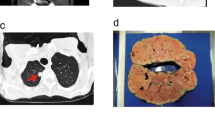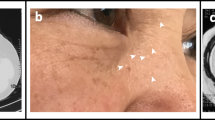Abstract
In this study, samples from multifocal renal tumors from two dogs affected with renal cystadenocarcinoma and nodular dermatofibrosis (RCND) were collected for detection of putative second hits in the FLCN gene. Genomic DNA from the samples was typed at the previously identified disease-associated missense mutation and cDNA representing the entire coding region of the FLCN gene was sequenced for mutation detection. Second hits with predicted functional implications for the wild-type FLCN allele were observed in 12 of 17 (71%) of the kidney tumor samples. The type of mutation of the second hits varied between the tumors. Different alternative splice mutations were detected, as well as loss of heterozygosity at the germline mutation and loss of transcription product of the wild-type FLCN allele. In total, the frequency and wide spectrum of second hits identified in the tumor samples suggests a tumor suppressor function of FLCN in the kidneys of RCND-affected dogs. No mutations were detected in skin nodules sampled from the two dogs. This shows that the skin tumors of RCND-affected dogs may be caused by haploinsufficiency of the FLCN gene product.


Similar content being viewed by others
References
Baba M, Hong SB, Sharma N, Warren MB, Nickerson ML, et al. (2006) Folliculin encoded by the BHD gene interacts with a binding protein, FNIP1, and AMPK, and is involved in AMPK and mTOR signaling. Proc Natl Acad Sci U S A 103:15552–15557
Birt AR, Hogg GR, Dube WJ (1977) Hereditary multiple fibrofolliculomas with trichodiscomas and acrochordons. Arch Dermatol 113:1674–1677
Jonasdottir TJ, Mellersh CS, Moe L, Heggebo R, Gamlem H, et al. (2000) Genetic mapping of a naturally occurring hereditary renal cancer syndrome in dogs. Proc Natl Acad Sci U S A 97:4132–4137
Khoo SK, Bradley M, Wong FK, Hedblad MA, Nordenskjold M, et al. (2001) Birt-Hogg-Dube syndrome: mapping of a novel hereditary neoplasia gene to chromosome 17p12–q11.2. Oncogene 20:5239–5242
Khoo SK, Kahnoski K, Sugimura J, Petillo D, Chen J, et al. (2003) Inactivation of BHD in sporadic renal tumors. Cancer Res 63:4583–4587
Lingaas F, Comstock KE, Kirkness EF, Sorensen A, Aarskaug T, et al. (2003) A mutation in the canine BHD gene is associated with hereditary multifocal renal cystadenocarcinoma and nodular dermatofibrosis in the German Shepherd dog. Hum Mol Genet 12:3043–3053
Lium B, Moe L (1985) Hereditary multifocal renal cystadenocarcinomas and nodular dermatofibrosis in the German shepherd dog: macroscopic and histopathologic changes. Vet Pathol 22:447–455
Moe L, Lium B (1997) Hereditary multifocal renal cystadenocarcinomas and nodular dermatofibrosis in 51 German shepherd dogs. J Small Anim Pract 38:498–505
Moe L, Gamlem H, Jonasdottir TJ, Lingaas F (2000) Renal microcystic tubular lesions in two 1-year-old dogs — an early sign of hereditary renal cystadenocarcinoma? J Comp Pathol 123:218–221
Nickerson ML, Warren MB, Toro JR, Matrosova V, Glenn G, et al. (2002) Mutations in a novel gene lead to kidney tumors, lung wall defects, and benign tumors of the hair follicle in patients with the Birt-Hogg-Dube syndrome. Cancer Cell 2:157–164
Okimoto K, Sakurai J, Kobayashi T, Mitani H, Hirayama Y, et al. (2004) A germ-line insertion in the Birt-Hogg-Dube (BHD) gene gives rise to the Nihon rat model of inherited renal cancer. Proc Natl Acad Sci U S A 101:2023–2027
Schmidt LS, Warren MB, Nickerson ML, Weirich G, Matrosova V, et al. (2001) Birt-Hogg-Dube syndrome, a genodermatosis associated with spontaneous pneumothorax and kidney neoplasia, maps to chromosome 17p11.2. Am J Hum Genet 69:876–882
van Steensel MA, Verstraeten VL, Frank J, Kelleners-Smeets NW, Poblete-Gutierrez P, et al. (2007) Novel mutations in the BHD gene and absence of loss of heterozygosity in fibrofolliculomas of Birt-Hogg-Dube patients. J Invest Dermatol 127:588–593
Vocke CD, Yang Y, Pavlovich CP, Schmidt LS, Nickerson ML, et al. (2005) High frequency of somatic frameshift BHD gene mutations in Birt-Hogg-Dube-associated renal tumors. J Natl Cancer Inst 97:931–935
Acknowledgment
The authors thank Ingvild Østengen, Department of Basic Sciences and Aquatic Medicine, Norwegian School of Veterinary Science, for technical assistance.
Author information
Authors and Affiliations
Corresponding author
Electronic supplementary material
Below is the link to the electronic supplementary material.
Rights and permissions
About this article
Cite this article
Bønsdorff, T.B., Jansen, J.H. & Lingaas, F. Second hits in the FLCN gene in a hereditary renal cancer syndrome in dogs. Mamm Genome 19, 121–126 (2008). https://doi.org/10.1007/s00335-007-9088-3
Received:
Accepted:
Published:
Issue Date:
DOI: https://doi.org/10.1007/s00335-007-9088-3




